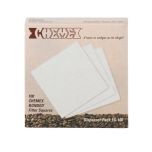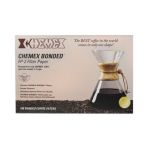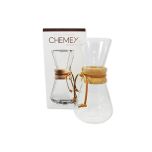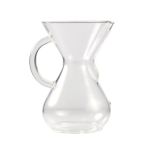
HISTORY
The Chemex Coffeemaker was invented in 1941 by Dr. Peter Schlumbohm PhD. Made simply from non-porous, borosilicate glass and fastened with a wood collar and tie, it brews coffee without imparting any flavours of its own. On permanent display at the Museum of Modern Art in New York and other fine museums, it is truly a work of art.
The iconic Chemex has remained unchanged for 70 years and counting. Chemex take pride in the quality of their product and customer service and they look forward to providing both for years to come.
The Chemex® coffeemaker is an elegant, one-piece, hourglass shaped vessel made of high quality, heat resistant glass. The traditional model comes to you with a polished wood collar and leather tie. The collar serves as an insulated handle around the middle of the coffeemaker.
Few products in this century can match the flawless blending of design and function of the Chemex®. Its visual elegance has earned it a place in the permanent collection of New York's Corning Museum of Glass. The Chemex® coffeemaker was also selected by the Illinois Institute of Technology as one of the 100 best designed products of modern times.
The Chemex® coffeemaker, together with Chemex-Bonded® Coffee Filter, makes perfect coffee. Clear, pure, flavourful and without bitterness or sediment every time. The coffee only comes in contact with the scientifically designed filter and non-porous glass. With the Chemex® method, you can make coffee as strong as you like without bitterness. Perfect for iced coffee and coffee flavouring for gourmet recipes. Because of its purity, Chemex® brewed coffee can be covered and stored in the refrigerator for reheating...without losing its flavour!
FAQ's
Q | What is the difference between the circle and square filter?
A | The only difference is the shape, the paper is the same. Some people find that the squares are easier to remove due to the points that rise above the carafe when the filter is placed in it.
Q | What is the “natural” filter paper?
A | Cleansed through a four stage process using extremely hot water, the paper is 100% cellular fiber made of primarily softwood such as pine.
Q | What are your cup measurements?
A | Five ounces (148ml) equals one cup.
Q | Can I use drip grind?
A | Yes, but it will increase the amount of time it takes to make a pot of coffee. Best results will be obtained from regular grind.
Q | Can I use fine grind?
A | No, it will not work well with our filter. Chemex filters are heavy to filter out unwanted fats and oils. Fine grind coffee will slow the filtration process.
Q | How can I avoid bitter coffee?
A | If the water that comes into contact with the coffee grounds is too hot, you will extract bitter elements from the coffee. The water should not be boiling when poured on the coffee grounds. Coffee oils, fats and sediment are the natural parts of the coffee bean that causes bitterness by forming as the brew ages. The longer the coffee sits the stronger it tastes. (Actually it is more bitter, not stronger.)
Q | Can I reheat coffee brewed with a Chemex?
A | Chemex may be reheated without being bitter. Make sure that brewed coffee is stored in a sealed glass container. Exposure to air causes loss of taste.
Q | Can I heat a Chemex coffeemaker on the stove?
A | Because the Chemex is glass, it should not be placed directly on the range of a stove with exposed coils. It may be placed on a glass covered stove range. For exposed coils utilize the Chemex wire grid.
Q | What advantages do Chemex filters offer?
A | Chemex filters are 20-30% heavier (more absorbent) to remove undesirable sediment particles and oils. Chemex filters were scientifically formulated to permit proper infusion time while filtering out sediment, oil, and fats. Infusion gives coffee a richer flavor and makes possible the fractional extraction of only the desirable parts of the coffee bean.
Q | What temperature should the water be when brewing?
A | The Chemex system was developed to provide the fractional extraction of only the desirable part of the coffee grounds.The coffee is brewed at and held at a temperature of between 80-95°C to avoid chemically altering the taste and making the coffee bitter.
Q | Can I put the coffeemaker on the range?
A | It is not recommended because the coffeemaker can break on direct heat. Utilize the Chemex wire grid on low heat setting. Also, if the range is a glass top model, the brewer is safe on it without a grid-low heat setting.
Q | My Chemex coffeemaker takes too long to make the coffee.
A | There are a few unique factors to keep in mind when brewing coffee with a Chemex:
- Make sure the three thickness of the filter are across the vent (if filter collapses into the vent it will slow or stop the coffee flow).
- Use regular, medium, coarse grind coffee - finer grinds will slow filtration rate.
- After soaking the grounds and allowing bloom time, pour water up to about 6mm from the top of the glass. It does take 6 to 7 minutes to make a ten cup pot of Chemex Coffee, but there is just no such thing as an instant gourmet dinner - and no such thing as a good fast cup of coffee. We think better coffee is more important than fast coffee. Besides, from a coffee chemistry standpoint, proper brewing requires an infusion period - only Chemex properly provides this.
Q | What is the difference between Chemex and other automatic coffee makers?
A | There are three primary differences:
- Glass versus plastic: All materials except glass will eventually corrode. That is why only glass beakers are used in laboratories. As most plastics age, tiny cracks will appear and they become resting places for mineral deposits or other things that are commonly present in water, especially tap water. These build-ups will eventually give your coffee a bad taste. Glass is the only non-porous material available so that these tiny cracks or fissures never appear in a Chemex coffeemaker no matter how many years it is used.
- Filters: Most filters for automatic coffeemakers have a flat bottom which can cause non-uniform extraction of the desirable parts of the coffee bean. Again, in laboratory extraction techniques the filter is always cone shaped like Chemex Bonded filters to assure uniform extraction. The filters for automatics are lighter in weight which means there is more opportunity for fine particles to escape. Chemex filters are 20-30% heavier- eliminating all sediment.
Brewing time: Automatic coffee makers generally boast about how fast they brew coffee. This is the very fact that adversely affects the character of the coffee brew. After the coffee grounds are wet for the first time, there should be 20-30 second waiting period to give the cells of the coffee grounds an opportunity to open up or “bloom” in preparation for the fractional extraction of the desirable part of the bean. Most filters for automatics are really only strainers since the water passes through too quickly for proper infusion of the coffee flavor. In automatics, half of the coffee is brewed before all of the grounds are even damp- so a very large portion of the coffee is wasted. Chemex filters allow this infusion period so the coffee has a richer flavor but is never bitter.
Are you interested in finding out more about the Chemex Coffee maker? You can check out our Chemex range here. If you have a question about the Chemex brewer, feel free to ask our team using the chat module on the bottom, left hand side of your screen. Alternatively, you can give us a call on 1300 724 249 or send us an email at [email protected].











